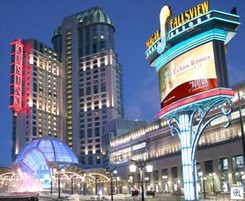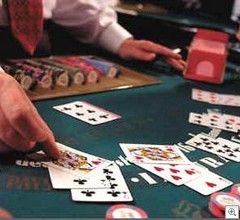 Ontario is the most populated province of Canada, with nearly 9 million people. It also produces the largest share of gaming revenues of any province. The three commercial casinos of the province generate 55 percent of all the casino revenues in Canada, and the leading racetracks of Canada are also located in Ontario. Nearly 65 percent of the racing handled in Canada is wagered in Ontario. The Woodbine track in Toronto hosted North America’s premium racing card, the Breeders’ Cup, in 1997. The tracks also have the most successful gaming machine operations in Canada. Ontario also has the most profitable lottery operation in Canada.
Ontario is the most populated province of Canada, with nearly 9 million people. It also produces the largest share of gaming revenues of any province. The three commercial casinos of the province generate 55 percent of all the casino revenues in Canada, and the leading racetracks of Canada are also located in Ontario. Nearly 65 percent of the racing handled in Canada is wagered in Ontario. The Woodbine track in Toronto hosted North America’s premium racing card, the Breeders’ Cup, in 1997. The tracks also have the most successful gaming machine operations in Canada. Ontario also has the most profitable lottery operation in Canada.
Ontario is clearly a leader in gaming volume today, but the province trailed others in initiating gaming operations. The lottery did not start until 1975, and lotto games were not in place until five years later. Instant tickets were not sold before 1982. The Ontario Lottery Corporation was responsible for overseeing charity gaming; however, until the mid-1990s charities could only sell raffle tickets and break-open tickets (similar to pull tabs) and conduct bingo games.
The Ontario Lottery Corporation may have hesitated a bit, but in the 1990’s it went into high gear. In 1993 it made a decision to have major casinos. To “test the waters” it authorized a pilot project for Windsor. Windsor was chosen for an obvious reason that provincial leaders made no attempt to conceal. Quite to the contrary, they boasted that the Windsor casino would market its gaming products to residents of the United States, more specifically residents of the Detroit metropolitan area. Only a one-mile waterway – the Detroit River – separated Windsor from Detroit, and there were two border crossing stations – a bridge and a tunnel. It was projected that 80 percent of the casino’s revenues would come from the United States. The Ontario Lottery Corporation secured a remodeled museum and art gallery building for a temporary casino. The government owned the casino, but it contracted with a consortium consisting of Caesars, Hilton, and Circus Circus companies to run the casino. The casino opened in May 1994, with greater than anticipated success. Seventy table games and 1,700 slot machines collected more revenue per square foot than had ever been collected in any casinos anywhere. Continuous crowds led the province to purchase a riverboat (the Northern Belle) and open it as a second Windsor casino. No longer was Windsor a pilot project. In 1998, a permanent facility was opened in a 1.2-million-square-foot facility on the riverfront. The facility included all the amenities of a Las Vegas casino – a hotel of 400 rooms, showrooms, multiple restaurants, and of course a gaming area of 100,000 square feet with 3,000 slot machines and 130 table games. The two temporary casinos closed.
Success is measured in many ways. One thing the success of Windsor’s casinos generated was a massive concern in the Detroit area over revenues leaving not only the city but also the country. Detroit retaliated by voting in 1995 to approve a nonbinding resolution supporting casinos. Then in 1996, the voters of the state of Michigan made it binding as they voted for a new state law permitting three casinos for the city of Detroit. The first one opened in 1999.
While things were happening in southwestern Ontario, the Ontario Lottery Corporation decided that more casinos should be located elsewhere. In 1996 temporary casinos were opened in Niagara Falls and also in Orilla. Although a temporary facility, the provincially owned Niagara Falls casino was managed by the Navagante Group – led by several former casino executives from Las Vegas. Soon the revenues at the Niagara Falls facility came to surpass those in Windsor. In November 1998, the corporation entered into an agreement with Hyatt Hotels for the construction of a permanent casino facility, which was to have a 350-room hotel, convention center, arts center, and cinema complex, along with show rooms, restaurants, and a 100,000-square-foot casino. The province also planned to place casino gaming in the popular Skylon tower that oversees the falls. Hyatt was to manage the new facilities in conjunction with a new management group of Americans. The facility is under construction as of 2001.
A new project is also slated for the Casino Rama in Orilla. As would be expected, this gaming hall has exceeded expectations. It is only one hour north of the Toronto metropolitan area. Casino Rama is owned by a Chippewa Band of First Nations peoples. The casino is operated by Carnival Cruise Lines’ casino division.
The three commercial casinos give 20 percent of their revenues directly to the Ontario provincial treasury; however, in the case of Casino Rama, the revenues are placed into a fund to benefit all the First Nations’ peoples of the province. The operators also take a 5 percent share of the gaming win. From the remaining 75% of the gaming revenues, all expenses are deducted. The residual net profits go to the province.
The Ontario Lottery Corporation also permitted charity casinos in the early 1990s. The casino nights featured table gaming only. These had to be “roving” casinos because no more than one night of gaming could be in one location per month. The “roving” games were operated by management companies, and many problems surfaced. For instance, with all the moving, equipment broke down frequently, and also there could be no permanent security systems installed to ensure that all gaming was honest and that all funds went where they were supposed to go. So in 1997, the government announced that it would create forty-four charity gaming sites in the province. How funds would be distributed was not clearly addressed, although most of the funds would go to the Ontario Lottery Corporation. (This presented a legal challenge, as the charity gaming laws require that most of the net revenues must go to the charity). The casinos would each be allowed forty tables and 150 machines. Most of the communities selected for the casino sites expressed displeasure with the idea, as citizens propelled round after round of protest at the government. In 1998 the province backed down and decreed that there would only be four “pilot” charity casinos, to be located in Thunder Bay, Sault Ste. Marie, Point Edward (adjacent to Sarnia), and Brantford. These cities were the only ones that had voted in favor of having charity casinos. Sault Ste. Marie and Point Edward were especially desirable sites as they bordered Michigan cities. One of these cities, Sault St. Marie, Michigan, boasted a very large Native American casino (the Kewadin Chippewa casino) that had been drawing most of its revenue from Canadians. Only Brantford did not have direct highway access to the United States and to potential American customers. Additional charity casinos were permitted for First Nations’ reserve lands. One is in operation near Port Erie. The four pilot casinos were allotted 450 gaming machines and eighty tables for players. All are now in operation and drawing good business from players.
The Ontario Lottery Corporation was also dissuaded from another plan owing to the protests of the citizens. The government announced that it would authorize 20,000 video machines for bars, taverns, and racetracks in the province. In 1998 the corporation abandoned the overall plan but instead finalized plans to place up to 20,000 machines in eighteen provincial racetracks, with as many as 2,000 at a single track. The operation of the machine gaming began in 1999 with 800 machines being installed at Windsor Raceway. Other tracks now have machines.
Archive for March, 2010Oklahoma – Gambling in AmericaPari-mutuel wagering was authorized by a 58 percent vote of the Oklahoma citizens in 1982. One major thoroughbred track was established, but it ceased operations for financial reasons. Several quarterhorse tracks continue to operate.
|
 No Comments »
No Comments »  In 1973 Ohioans voted for legalized lottery gambling with a 64 percent majority vote. The active games generate over $2 billion in sales. Net revenues are dedicated to educational programs. Since the 1930s most forms of horseracing (thoroughbred, harness, and quarter horse) have had pari-mutuel betting. Telephone wagering and intertrack simulcast race wagering are permitted and are operational; offtrack betting has been approved. Ohio also has a very active charitable gaming operation with both bingo games and Las Vegas nights.
In 1973 Ohioans voted for legalized lottery gambling with a 64 percent majority vote. The active games generate over $2 billion in sales. Net revenues are dedicated to educational programs. Since the 1930s most forms of horseracing (thoroughbred, harness, and quarter horse) have had pari-mutuel betting. Telephone wagering and intertrack simulcast race wagering are permitted and are operational; offtrack betting has been approved. Ohio also has a very active charitable gaming operation with both bingo games and Las Vegas nights.